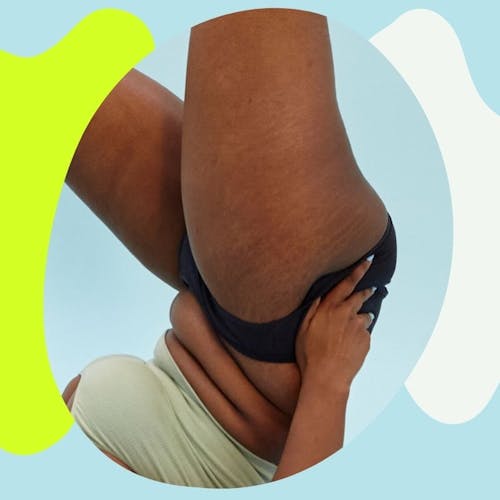This website uses cookies to enhance the user experience. By using Yoppie you are agreeing to our use of cookies.
Feel Like Your Tampon's Hitting A Wall?
Written by Yoppie
26 Apr 2021
Look at a diagram
Use smaller tampons
Use an applicator
Try lubricant
Is it just tension, or is it vaginismus?
What is vaginismus?
How to relax when inserting a tampon
Are you dealing with a particularly defiant vagina? One that, no matter how much you poke and prod and try to relax and poke some more, just won’t let you insert a tampon? If that sucker won’t budge, don’t worry. You’re certainly not the first to experience this. It’s pretty common, and there are a few reasons why it could be happening to you.
Before we dive in, it’s worth mentioning that there’s no shame in not knowing how to insert a tampon (no matter what age you are) because we don’t all get a step-by-step tutorial on this stuff, and in many cases we’re left to figure it out on our own. If you feel confident that you have read the instructions on the side of the packaging correctly, yet nothing seems to be working, here are some other things you can try:
Look at a diagram
Unsure of what’s inside your vagina? You may be pushing the tampon in at the wrong angle. If you’re worried about this, it can sometimes help to look at a diagram while you insert your tampon so you can picture where it’s going. This also helps if you worry about the tampon getting stuck - rest assured that what goes up will come down!
Use smaller tampons
If you’re struggling to insert a tampon, make sure you’re trying the smallest size you can first. Even if you have had sex before, you may simply have a smaller hole down there that the tampon has to get through, so give it the best chance by choosing the smallest size.
Use an applicator
If you need more help, applicators are the way to go. They receive a lot of bad press because of the plastic waste they produce, but many people find them necessary for their tampon insertion, so if that’s you, go for it! An applicator usually provides more of a smooth surface to help the tampon slip in, and doesn’t require quite so much bending to reach your fingers into your vagina. Plus you can easily find eco-friendly applicator tampons that use cardboard rather than plastic, just like Yoppie's own in fact!
Try lubricant
If you need even more help (not a problem, plenty of people do!) then there’s one more trick up our sleeve. Lube! You might think of the sexy tubes of flavoured stuff in the supermarket next to the condoms, and you’d be right, but don’t forget there are also lots of personal lubricants marketed without sex in mind. Just some good old smooth, slippery lube to help that tampon glide on in there. Adding a little of this to the entrance of your vagina, or to the applicator, can often make a difference.
Is it just tension, or is it vaginismus?
The main issue that hinders tampon insertion for most is the muscles in the vagina tensing up and stopping anything from passing through. If you’re thinking ‘Pah! Pelvic floor muscles are no match for a tampon’... well you’re wrong. They’re pretty tough, and can put up a fight when something tries to go in there.
In most cases, relaxation activities (which you’ll find below) can help, but in some cases they don’t. If you’ve tried many times to insert a tampon to no avail, and no matter how much you try to relax it won’t happen, you may have something called vaginismus.
What is vaginismus?
Vaginismus isn’t dangerous so it’s nothing to worry about, but it can cause frustration. It happens when the muscles in and around the vagina tighten up when you try to insert a tampon (or a penis, or whatever, for that matter!). It can be a bit painful for some, or very painful for others, but mainly it’s emotionally frustrating.
The causes of this condition vary; some believe it’s the body's reaction to a fear of penetration, whether conscious or not. Other times it can be triggered by a medical condition, trauma from childbirth, menopause, physical or sexual abuse, certain medications, and more. But don’t worry, there are things you can do to loosen the muscles. The best way to find the information you need is via your GP - they can give you helpful exercises.
The good news is vaginismus can come and go, so if you do have this condition it may take a little longer for you to get used to using tampons but it doesn’t mean you won’t be able to use them in future.
Want to know more about vaginismus? We have a whole blog about it right here.
How to relax when inserting a tampon
If you don’t have vaginismus, but you find yourself tensing up a little when trying to insert a tampon, there are a few things you can try to encourage those muscles to relax:
- Lie down on your bed. You may feel more relaxed at this angle (since your brain probably thinks it’s going to sleep!) and you can better relax your core muscles in this position too.
- Have a bath first. A relaxing bath can often soothe the muscles before you attempt to insert your tampon, which should make it easier.
- Meditate or do breathing exercises for a few minutes before you try to insert your tampon. Never underestimate the power of your own breath!
- Experiment with different positions until you find what feels most comfortable. One leg up, on your knees, upside down, it’s all fine! Just be careful you don’t tip over…
Got a question about inserting a tampon? Don't be embarrassed! Shout out in our private Facebook group or drop us a note on Insta @itsyoppie. Don't forget that our personalised period box can get organic tampons (with or without eco-friendly applicators!) and more delivered easily and regularly through your letterbox, so that's one less headache to think about during your cycle.
Fact checked by Doctor Samantha Miller.
Section jump
Back to top
Subscribe To Our Newsletter
YOPPIE





© 2025 Yoppie is a registered trademark of Phlo Technologies Ltd.
Yoppie's supplements are not a substitute for a varied diet and healthy lifestyle and are not intended to diagnose, treat, or cure any disease. If you are pregnant, breastfeeding, have a medical condition or are under medical supervision, please consult with your doctor before taking any of our products.






